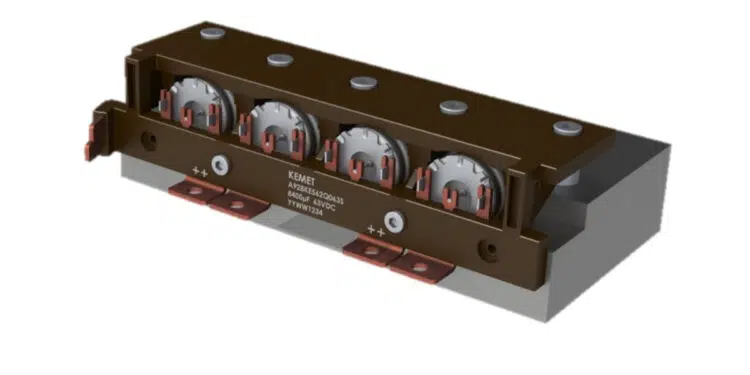1. A Primer on Aluminum Electrolytic Capacitors
The development of the electrolytic capacitor (e-cap) has been one of the main factors in the successful miniaturization and increased performance of many modern-day electronics. The basic e-cap construction is shown in the figure below:

Since capacitance is a function of surface area, aluminum foils are first etched to create a rough contour with maximal contact area, resulting in high capacitance and optimal CV-value.
A second foil layer and a paper separator are added to fully complete the capacitor structure, producing an excellent terminal contact with this electrolyte. This aluminum-electrolyte-paper sandwich is then rolled or “wound” into a can and sealed with two terminals.
2. Aluminum Electrolytic Capacitors in Low Voltage Automotive Systems
2.1 DC-Link Capacitors
DC-link capacitors are used to provide a stable DC-voltage, limiting voltage fluctuations even under high ripple current loads, -fluctuations created by the inverter. The DC-link capacitors are acting as a local energy source, connected to the DC- board-net – close to the power electronics (–> low impedance).

Key requirements, for automotive DC-link capacitors:
- Ripple current capability
- Low ESR
- High-temperature capability
- Low thermal resistance (…especially when mounted heat-sinked to metallic chassis)
- Operational life
- Low impedance
- Low inductance
- High reliability
2.2 48V Automotive Systems and Applications
The increasing electrical power demand in modern cars is the primary cause for introducing the 48V board net. Major automotive OEMs will fully migrate to 48V mild hybrid solutions within a few years, in addition to offering plug-in hybrid electric vehicles (PHEVs) and electric vehicles (EVs). Reduced CO2 emissions and improved fuel consumption are the key drivers for this evolution.
Mild hybrid systems are typically designed for 10-30 kW charging power. A maximum 40kW peak output power can be confirmed on projects today, showing full compatibility with future 48V drives. This creates a need for a DC-link capacitor module, corresponding to 3-6 axial electrolytic capacitors, connected in parallel, using well-known Axial Aluminum wet technology and considering the Axial Hybrid for high power versions trend. Typically, the capacitors are heatsinked to the metallic chassis to achieve max ripple current capability.

2.3 Mounting to a Heatsink
Robust mounting to the heatsink results in excellent heat transfer (low thermal resistance), lower capacitor bank temperature (extended operational life), and significantly improved ripple current capability. At the same time, excellent mechanical robustness and vibration resistance is achieved.


The application chassis (metallic) can preferably be adapted for heatsinking the module. The chassis/ heatsink can be either air-cooled or water-cooled. Thermal paste or thermal pad should be used to ensure low thermal resistance and optimal heat transfer.
3. Electrical Characterization
The following electrical characterization was performed on a 63V 5600μF module measuring 135mm x 52mm x 31mm, part number: A928KE562Q063.



































